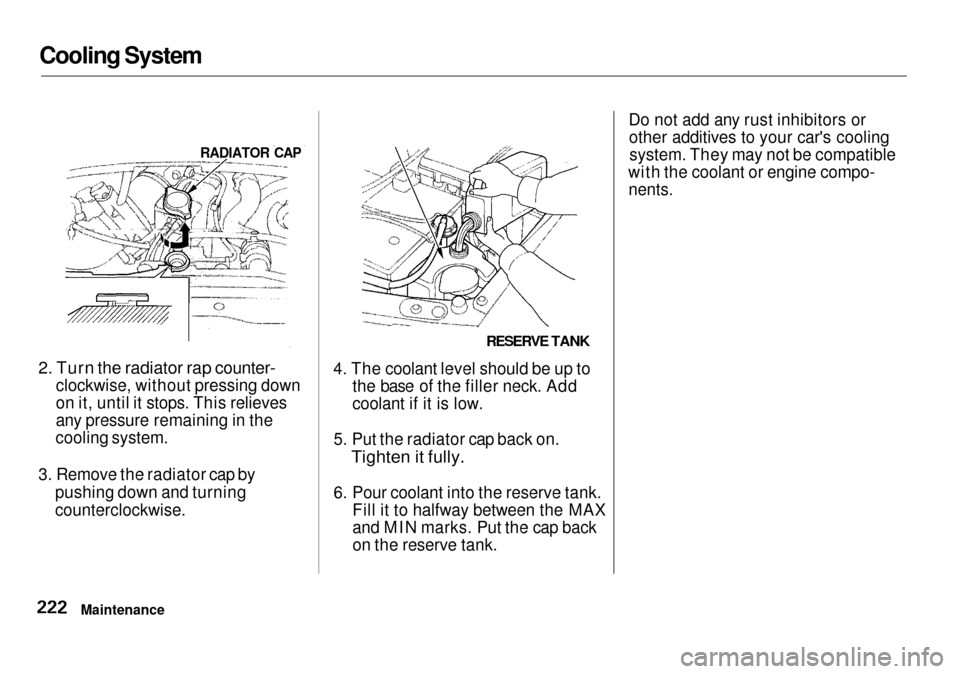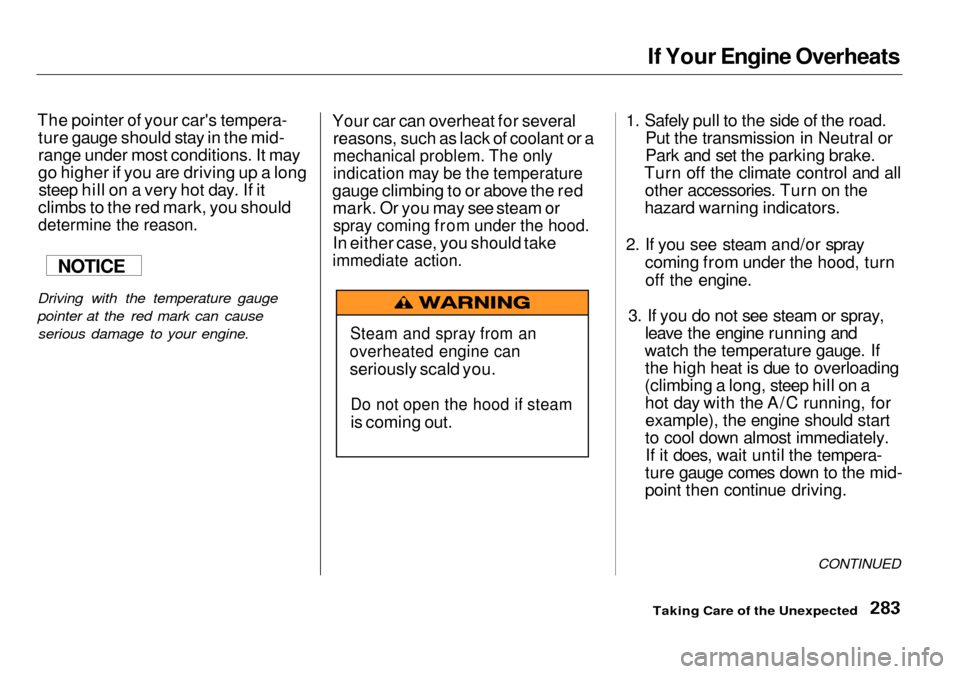engine coolant Acura RL 2001 3.5 User Guide
[x] Cancel search | Manufacturer: ACURA, Model Year: 2001, Model line: RL, Model: Acura RL 2001Pages: 333, PDF Size: 4.28 MB
Page 225 of 333

Cooling System
2. Turn the radiator rap counter-
clockwise, without pressing down
on it, until it stops. This relieves
any pressure remaining in the
cooling system.
3. Remove the radiator cap by pushing down and turning
counterclockwise. 4. The coolant level should be up to
the base of the filler neck. Add
coolant if it is low.
5. Put the radiator cap back on.
Tighten it fully.
6. Pour coolant into the reserve tank.
Fill it to halfway between the MAX
and MIN marks. Put the cap back
on the reserve tank.
Do not add any rust inhibitors or
other additives to your car's coolingsystem. They may not be compatible
with the coolant or engine compo- nents.
Maintenance RADIATOR CAP
RESERVE TANK
Page 226 of 333

Cooling System
Replacing Engine Coolant
The cooling system should be completely drained and refilled with
new coolant according to the time
and distance recommendations in
the maintenance schedule. Only use Honda All Season Antifreeze/Coolant Type 2. Use of any non-
Honda coolant or plain water can
result in corrosion and deposits in
the cooling system.
Draining the coolant requires access
to the underside of the car. Unless
you have the tools and knowledge,
you should have this maintenance done by a skilled mechanic.
1. Turn the ignition ON (II). Turn
the heater temperature control
dial to maximum heat (climate
control to 90°F/32°C). Turn off
the ignition. Open the hood. Make
sure the engine and radiator are
cool to the touch.
2. Remove the radiator cap.
3. Loosen the drain plug on the
bottom of the radiator. The
coolant will come out through the
hole in the splash cover.
CONTINUED
Maintenance
DRAIN PLUG
Page 227 of 333

Cooling System
4. On the right side of the engine
block, remove the clip with a plier, and then remove the drain cap.
5. Remove the reserve tank from its
holder by pulling it straight up.Drain the coolant, then put the
tank back in its holder.
6. When the coolant stops draining,
tighten the drain plug at the
bottom of the radiator.
Put the drain cap back in place
tightly, then reinstall the clip on
the drain cap securely.
Maintenance
CLIP
DRAIN CAP RESERVE TANK CAP
RESERVE TANK
HOLDER
Page 228 of 333

Cooling System
7. Remove the two bolts and the
three nuts with a 7/16 in (10 mm)
wrench, then remove the engine
cover.
8. Loosen the bleeder bolt on top of
the engine.
9. Pour Honda All Season
Antifreeze/Coolant Type 2 into the radiator up to the base of the
filler neck. This coolant is a
mixture of 50 percent antifreeze
and 50 percent water. Pre-mixing
is not required.
The cooling system capacity is:
1.61 US gal (6.1 , 1.34 Imp gal)
10.Tighten the bleeder bolt when
coolant comes out in a steady
stream with no bubbles.
CONTINUED
Maintenance
BOLTS
NUTS
BLEEDER BOLT
Page 229 of 333

Cooling System
11.Fill the reserve tank to the MAX
mark. Install the reserve tank cap.
12.Check the level in the radiator,
add coolant if needed.
13.Install the engine cover. First
tighten the two bolts on the front of the engine cover, then tighten
the three nuts on the engine cover.
Tightening torque:
7 lbf .
ft (10 N .
m , 1.0 kgf .
m)
14.Install the radiator cap, and
tighten it to the first stop.
15.Start the engine and let it run until
the radiator cooling fan comes on
at least twice. Then stop the
engine.
16.Remove the radiator cap. Pour
coolant into the. radiator up to the base of the filler neck and into the
reserve tank up to the MAX mark.
17.Start the engine and hold it at
1,500 rpm until the cooling fan comes on. Turn off the engine.
Check the coolant level in the
radiator and add coolant if needed.
18.Install the radiator cap, and
tighten it fully.
19.If necessary, fill the reserve tank
to the MAX mark. Install the
reserve tank cap.
Maintenance
Fill up to here
FILLER NECK
RESERVE TANK
Page 286 of 333

If Your Engine Overheats
The pointer of your car's tempera- ture gauge should stay in the mid-
range under most conditions. It may
go higher if you are driving up a longsteep hill on a very hot day. If it
climbs to the red mark, you should
determine the reason.
Driving with the temperature gauge
pointer at the red mark can cause
serious damage to your engine.
Your car can overheat for several
reasons, such as lack of coolant or a
mechanical problem. The only
indication may be the temperature
gauge climbing to or above the red mark. Or you may see steam or
spray coming from under the hood.
In either case, you should take
immediate action.
1. Safely pull to the side of the road.
Put the transmission in Neutral or
Park and set the parking brake.
Turn off the climate control and all other accessories. Turn on the
hazard warning indicators.
2. If you see steam and/or spray coming from under the hood, turnoff the engine.
3. If you do not see steam or spray, leave the engine running and
watch the temperature gauge. If the high heat is due to overloading
(climbing a long, steep hill on a hot day with the A/C running, forexample), the engine should start
to cool down almost immediately. If it does, wait until the tempera-
ture gauge comes down to the mid-
point then continue driving.
CONTINUED
Taking Care of the Unexpected
NOTICE
Steam and spray from an
overheated engine can
seriously scald you.
Do not open the hood if steam
is coming out.
Page 287 of 333

If Your Engine Overheats
4. If the temperature gauge stays at the red mark, turn off the engine.
5. Wait until you see no more signs of steam or spray, then open the
hood.
6. Look for any obvious coolant leaks, such as a split radiator hose.
Everything is still extremely hot,so use caution. If you find a leak, it
must be repaired before you
continue driving (see Emergency
Towing on page 296 ).
7. If you don't find an obvious leak, check the coolant level in the
radiator reserve tank (see page172 ). If the level is below the
MIN mark, add coolant to halfway
between the MIN and MAX marks.
8. If there was no coolant in the reserve tank, you may also have toadd coolant to the radiator. Let the
engine cool down until the pointer reaches the middle of the tempera-
ture gauge, or lower, before check- ing the radiator.
9. Using gloves or a large heavy cloth, turn the radiator capcounterclockwise, without pushing
down, to the first stop. This
releases any remaining pressure in
the cooling system. After the
pressure releases, push down on
the cap and turn it until it comes off. 10.Start the engine and set the
temperature control dial tomaximum (climate control to
FULL AUTO at 90°F/32°C). Add
coolant to the radiator up to the
base of the filler neck. If you do not have the proper coolant
mixture available, you can add
plain water. Remember to have
the cooling system drained andrefilled with the proper mixture assoon as you can.
11. Put the radiator cap back on tightly. Run the engine and watch
the temperature gauge. If it goes
back to the red mark, the engine
needs repair. (See Emergency
Towing on page 296 .)
12.If the temperature stays normal, check the coolant level in the
radiator reserve tank. If it has
gone down, add coolant to the MAX mark. Put the cap back on
tightly.
Taking Care of the Unexpected
Removing the radiator cap
while the engine is hot can
cause the coolant to spray out, seriously scalding you.
Always let the engine and
radiator cool down before
removing the radiator cap.
Page 305 of 333

Specifications
* 1
: Including the coolant in the reserve tank and that remaining in the
engine.
Reserve tank capacity:
0.172 US gal (0.65 l , 0.143 Imp gal)
* 2 : Excluding the oil remaining in the engine.
Technical Information
Page 325 of 333

Index
Bulb Replacement
Back-up Lights........................... 256
Brake Lights............................... 256
Ceiling Lights............................. 259
Courtesy Lights......................... 259
Fog Lights.................................. 253
Front Side Marker Lights......... 255
Headlights.................................. 252
High-mount Brake Light.......... 257
License Plate Lights.................. 258
Specifications............................. 303
Trunk Light................................ 260
Tum Signal Lights..................... 255
Bulbs, Halogen............................... 252
Cancel Button................................... 75
Capacities Chart............................. 302
Carbon Monoxide Hazard.............. 49
Carrying, Cargo............................. 176
Cassette Player
Care............................................. 156
Operation............................ 141, 153
CAUTION, Explanation of............... ii
CD Changer................... 144, 157, 159
Ceiling Lights................................. 118
Certification Label......................... 300
Chains............................................. 249
Changing Oil
How to......................................... 219
When to....................................... 208
Changing a Flat Tire..................... 273
Changing Engine Coolant............. 223
Charging System Indicator.... 54, 287
Checklist, Before Driving............. 180
Child Safety...................................... 20
Child Seats........................................ 24
Tether Anchorage Point............. 39
Childproof Door Locks................... 85
Cigarette Lighter........................... 116
Cleaner. Air.................................... 231
Cleaning
Aluminum Wheels..................... 265
Carpeting.................................... 266
Exterior....................................... 264
Fabric.......................................... 266
Interior........................................ 266
Leather........................................ 266
Seat Belts.................................... 266
Vinyl............................................ 266
Windows..................................... 267
Wood Trim................................. 267
Climate Control System................ 122
Clock, Setting the.......................... 109
Code, Audio System...................... 164
CO in the Exhaust......................... 308
Coin Box......................................... 113
Cold Weather, Starting in............. 181
Compact Spare............................... 272
Console Compartment.................. 113
Consumer Information*................ 314
Controls, Instruments and.............. 51Coolant Adding......................................... 221
Checking..................................... 172
Proper Solution.......................... 221
Replacing.................................... 223
Temperature Gauge.................... 60
CoiTosion Protection..................... 269 Courtesy Lights............................. 119
Crankcase Emissions Control
System......................................... 308
Cruise Control Operation............... 73
Customer Relations Office........... 314
Page 326 of 333

Index
DANGER, Explanation of................. ii
Dashboard.................................... 2, 52
Daytime Running Lights................. 65
Defects, Reporting Safety............. 317
Defogger, Rear Window................. 71
Defrosting the Windows.......128,
132
Differential
Oil............................... 229
Dimensions..................................... 302
Dimming the Headlights................ 63
Dipstick
Automatic Transmission........... 228
Engine Oil................................... 171
Directional Signals........................... 66
Disc Brake Wear Indicators......... 187
Disposal of Used Oil...................... 220
Doors
Locking and Unlocking............... 81
Lockout Prevention..................... 82
Monitor Light............................... 57
Power Door Locks....................... 81
DOT Tire Quality Grading........... 304
Drive Belts...................................... 242
Driver and Passenger Safety............ 5
Driving............................................ 179
Economy..................................... 173
In Bad Weather.......................... 194
In Foreign Countries................. 307
Driving Position Memory
System......................................... 101
Economy, Fuel............................... 173
Emergencies on the Road............. 271 Battery, Jump Starting.............. 280
Brake System Indicator............ 289Changing a Flat Tire................. 273
Charging System Indicator...... 286
Checking the Fuses................... 292
Low Oil Pressure Indicator...... 285
Malfunction Indicator Lamp.... 287
Manually Closing Moonroof.... 290
Overheated Engine................... 283
Emergency Brake.......................... 109
Emergency Flashers....................... 70
Emergency Towing....................... 296
Emissions Controls........................ 308
Emissions Testing,State............... 311 Engine
Belts............................................. 242
Coolant Temperature Gauge ..... 60
Malfunction Indicator
Lamp................................. 55, 287
Oil Pressure Indicator......... 54, 285
Oil. What Kind to Use............... 217
Overheating................................ 283
Specifications............................. 303
Speed Limiter............................. 184
Starting........................................ 181
Engine Speed Limiter.................... 184
Ethanol in Gasoline....................... 306
Evaporative Emissions Controls.. 308
Exhaust Fumes................................ 49
Exhaust Gas Recirculation
System......................................... 309
Expectant Mothers, Use of Seat
Belts by.........................................18
Exterior, Cleaning the................... 264
Fabric, Cleaning............................. 266
CONTINUED